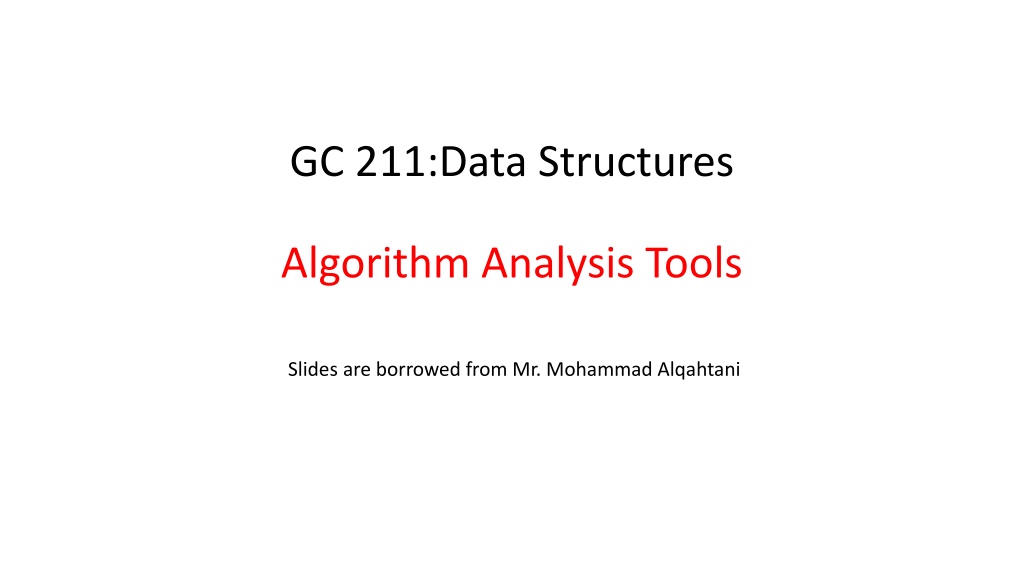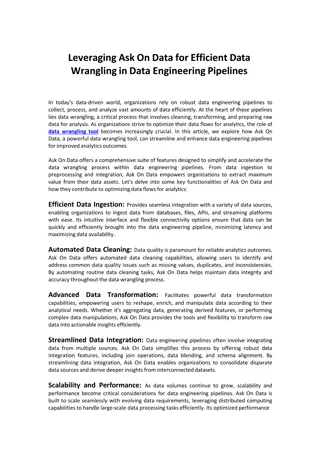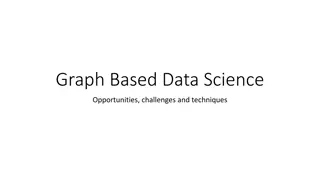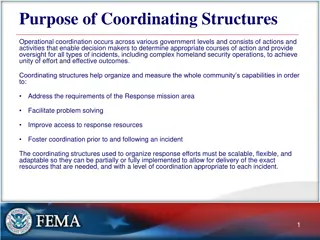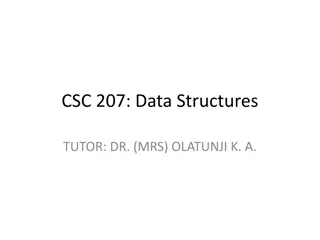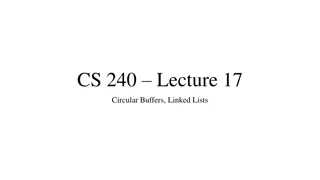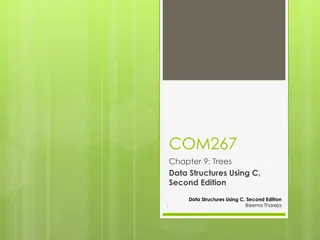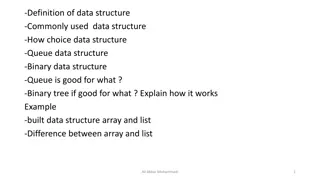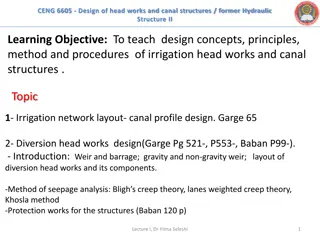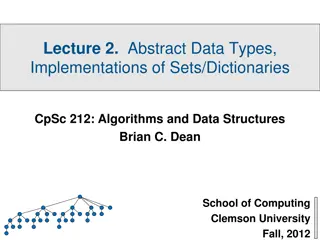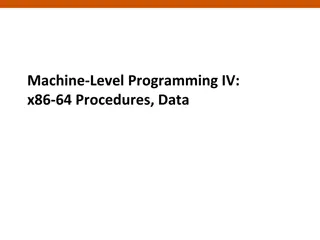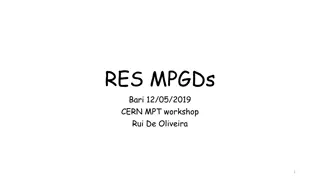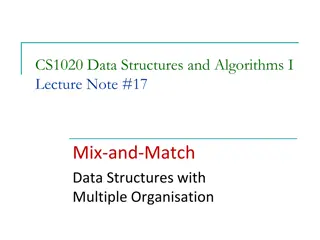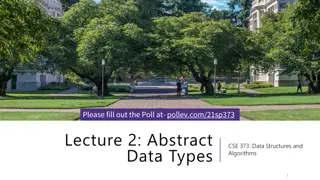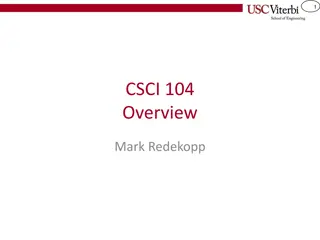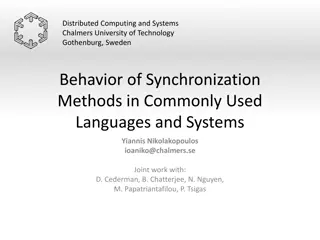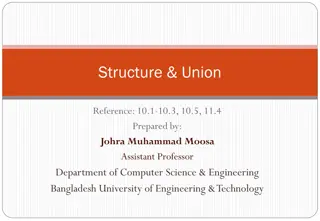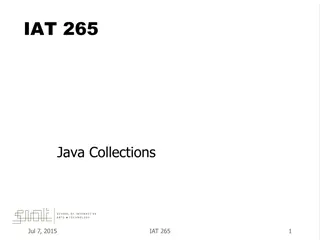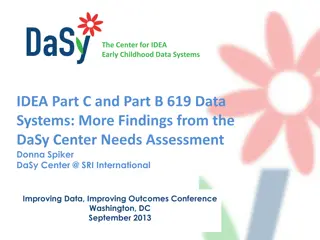GC 211:Data Structures
Algorithm analysis is a crucial aspect of computer science, helping determine the efficiency of algorithms in terms of computational time and memory usage. This analysis involves evaluating algorithms using theoretical and experimental approaches, focusing on primitive operations and their impact on performance.
Uploaded on Feb 20, 2025 | 0 Views
Download Presentation

Please find below an Image/Link to download the presentation.
The content on the website is provided AS IS for your information and personal use only. It may not be sold, licensed, or shared on other websites without obtaining consent from the author. Download presentation by click this link. If you encounter any issues during the download, it is possible that the publisher has removed the file from their server.
E N D
Presentation Transcript
GC 211:Data Structures Algorithm Analysis Tools Slides are borrowed from Mr. Mohammad Alqahtani
Algorithm Analysis: Motivation Aproblem can be solved in many different ways Single problem, many algorithms Which of the several algorithms should I choose? We use algorithm analysis to answer this question o Writing a working program is not good enough o The program may be inefficient! o If the program runs on a large data set, then the running time becomes an issue
What is Algorithm Analysis? Amethodology to predict the resources that the algorithm requires Computer memory Computational time We ll focus on computational time It does not mean memory is not important Generally, there is a trade-off between the two factors o Space-time trade-off is a common term
How to Analyse Algorithms? ExperimentalApproach Implement algorithms as programs and run them on computers Not a good approach, though! o Results only for a limited set of test inputs o Difficult comparisons due to the experiment environments (need the same computers, same operating systems, etc.) o Full implementation and execution of an algorithm We need an approach which allows us to avoid experimental study
How to Analyse Algorithms? TheoreticalApproach General methodology for analysing the running time o Considers all possible inputs o Evaluates algorithms in a way that is independent from the hardware and software environments oAnalyses an algorithm without implementing it Count only primitive operations used in an algorithm Associate each algorithm with a function f(n) that characterises the running time of the algorithm as a function of the input size n oA good approximation of the total number of primitive operations
Primitive Operations Basic computations performed by an algorithm Each operation corresponding to a low-level instruction with a constant execution time Largely independent from the programming language Examples Evaluating an expression (x + y) Assigning a value to a variable (x 5) Comparing two numbers (x < y) Indexing into an array (A[i]) Calling a method (mycalculator.sum()) Returning from a method (return result)
Counting Primitive Operations Total number of primitive operations executed is the running time of an algorithms is a function of the input size Example Algorithm ArrayMax(A, n) currentMax A[0] for i 1;i<n; i i+1 do if A[i]>currentMax then currentMax A[i] endif endfor return currentMax # operations 2: (1 +1) 3n-1: (1 + n+2(n- 1)) 2(n 1) 2(n 1) 1 Total: 7n 2
Example 2 for(i = 1; i < n+1; i++){ sum = sum + i;prod = prod*(i); } 1. i = 1 // 1 operation 2. if i <n+1 //n+1 operations 3. sum = sum + I //2n operations 4. prod = prod*(i) //2n operations 5. i++ // 2n operations T(n)=7n+2
Algorithm Efficiency: Growth Rate An algorithm s time requirements can be expressed as a function of (problem) input size Problem size depends on the particular problem: For a search problem, the problem size is the number of elements in the search space For a sorting problem, the problem size is the number of elements in the given list How quickly the time of an algorithm grows as a function of problem size -- this is often called an algorithm s growth rate
Algorithm Growth Rate Which algorithm is the most efficient? [The one with the growth rate Log N.]
Algorithmic Time Complexity Rather than counting the exact number of primitive operations, we approximate the runtime of an algorithm as a function of data size time complexity Algorithms A, B, C and D (previous slide) belong to different complexity classes We ll not cover complexity classes in detail We ll briefly discuss seven basic functions which are often used in complexity analysis
Seven Basic Function 1. Constant function 2. Linear function 3. Quadratic function 4. Cubic function 5. Log function 6. Log linear function 7. Exponential function f(n) = c f(n) = n f(n) = n2 f(n) = n3 f(n) = log n f(n) = n log n f(n) = 2n
Algorithmic Runtime Worst-case running time measures the maximum number of primitive operations executed The worst case can occur fairly often oe.g. in searching a database for a particular piece of information Best-case running time measures the minimum number of primitive operations executed o Finding a value in a list, where the value is at the first position o Sorting a list of values, where values are already in desired order Average-case running time the efficiency averaged on all possible inputs maybe difficult to define what average means
Complexity Classes Suppose the execution time of algorithm A is a quadratic function of n (i.e. an2 + bn + c) Suppose the execution time of algorithm B is a linear function of n (i.e. an + b) Suppose the execution time of algorithm C is a an exponential function of n (i.e. a2n) For large problems higher order terms dominate the rest These three algorithms belong to three different complexity classes
Big-O and Function Growth Rate We use a convention O-notation (also called Big-Oh) to represent different complexity classes The statement f(n) is O(g(n)) means that the growth rate of f(n) is no more than the growth rate of g(n) g(n) is an upper bound on f(n), i.e. maximum number of primitive operations We can use the big-O notation to rank functions according to their growth rate
16 Big-O: Functions Ranking BETTER constant time log time linear time O(1) O(log n) O(n) O(n log n) log linear time O(n2) O(n3) O(2n) quadratic time cubic time exponential time WORSE
Big Oh: Some Examples n3 3n = O(n3) 1 + 4n = O(n) 7n2 + 10n + 3 = O(n2) 2n + 10n + 3 = O(2n)
Asymptotic Algorithm Analysis Determines the running time in big-O notation Asymptotic analysis find the worst-case number of primitives operations executed as a function of the input size express this function with big-O notation Example: algorithm arrayMax executes at most 7n 2primitive operations algorithm arrayMax runs in O(n) time
Practice: Express the following functions in terms of Big-O notation (a, b and c are constants) 1. f(n) = an2 + bn + c 2. f(n) = 2n + n log n + c 3. f(n) = n log n+ b log n + c
